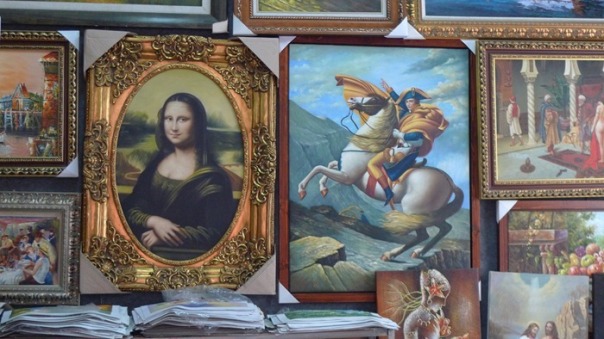The development of Shenzhen has been through the concerted efforts of the government and its people but what is often ignored are the small pockets of thriving novelty industries that have brought the spotlight to Shenzhen all across the world. One such industry is the oil painting industry centered on the dafen oil painting village. Started by a businessman from Hong Kong named Huang Jiang in the 1980’s, the oil painting soon became a thriving business community with more than 3000 artists replicating or producing more than 6000 paintings a day. And the rapid development of Shenzhen along with the increased demand for oil painting replicas the easy supply of which comes from the village made this obscure area in Shenzhen, one of the most visited places in Shenzhen. Most of the artists who work are well trained in the art and some are capable of producing a score of replicas in a day.
I visited Da-fen last month. The village developed as a gated enclave was a delight right from the start. I was greeted by the iconic ‘hand holding the paintbrush’ at the gates of the village signifying of what is to come next. I immediately fell in love with what I saw next. Streets lined with beautiful paintings stacked upon each other, artists deep in thought contemplating their next brushstroke, art connoisseurs and critics looking for that one perfect painting from the lot. The dafen enclave sometimes reminded me of medieval Europe or of the streets of Paris where painters lined up to earn a living painting portraits. The da fen enclave supports over 3000 families involved in the business. It comes as no surprise that the streets and shops are bustling with children. “Most shops are family owned. I like working as a painter here, it is good life for my family away from the overcrowded city and the pay is good too”, said Hu Liling, when asked about his life at dafen. “And most foreign people call my kid sweet when they visit my shop”, he laughingly adds.
The business at the village can be categorized into many types. Painters like Hu Liling run small inclusive shops selling portraits or simple replicas on a small scale. Hu, undertakes portraits too. He said that it is a new fad among the rich Chinese, to have their portrait adorns their living room. He charges anywhere between 400 to 1000 RMB for a portrait. “Sometimes I get invited to people’s homes to draw. I charge more than 2000 for that”, he said. “Tourists love getting their portrait drawn too. Charge them extra. I charge extra because when they go back they tell their friends the painting costs thousands of dollars, so I don’t mind charging a few hundred kuai’s extra”, he says laughing hysterically.Custom made paintings at da-fen can range from subtle family portraits to quirky and oddballs such as a painting of ‘you naked except a Napoleonic cap riding a fire breathing laser shooting T-rex’ picture to the left.
Others like John, he preferred his English name, own large galleries that cater exclusively to orders from overseas. John, in his art gallery employs more than 70 artists and undertakes orders from Europe, North America etc. He said the most demanded paintings are those of exotic sceneries from China and India. “People in the west just love the natural beauty of the east. Probably because they don’t have it”, he said with apparent seriousness when asked about this unusual demand.
After talking to John, I spent the rest of the day taking a stroll on the streets of dafen experiencing sights from Paris, London and Venice right here in Shenzhen. My day at dafen came to an end with a cup of Turkish coffee at a small café as the sun set on the village and shops closed to prepare for another day.



